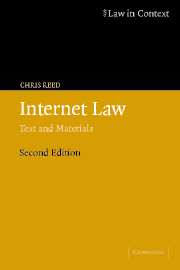Book contents
- Frontmatter
- Contents
- Preface
- Table of UK Statues
- Table of statutes–foreign jurisdictions
- Table of European Communities legislation
- Table of Conventions and Agreements
- Table of cases
- Introduction
- 1 The Internet as a distributed environment
- 2 From each according to his ability : actors and activities in the Internet world
- 3 An infinity of scarce resources : ownership and use of Internet resources
- 4 New actors on a new stage : intermediary liability in the Internet world
- 5 On the Internet, nobody knows you're a dog: identity and identification
- 6 Old wine in new bottles : traditional transactions in the Internet environment
- 7 The long arm of the law : cross-border law and jurisdiction
- 8 Legislative and regulatory arbitrage
- 9 Enforceability in the Internet environment
- 10 Facing the legislative and regulatory challenge
- Index
5 - On the Internet, nobody knows you're a dog: identity and identification
Published online by Cambridge University Press: 05 June 2012
- Frontmatter
- Contents
- Preface
- Table of UK Statues
- Table of statutes–foreign jurisdictions
- Table of European Communities legislation
- Table of Conventions and Agreements
- Table of cases
- Introduction
- 1 The Internet as a distributed environment
- 2 From each according to his ability : actors and activities in the Internet world
- 3 An infinity of scarce resources : ownership and use of Internet resources
- 4 New actors on a new stage : intermediary liability in the Internet world
- 5 On the Internet, nobody knows you're a dog: identity and identification
- 6 Old wine in new bottles : traditional transactions in the Internet environment
- 7 The long arm of the law : cross-border law and jurisdiction
- 8 Legislative and regulatory arbitrage
- 9 Enforceability in the Internet environment
- 10 Facing the legislative and regulatory challenge
- Index
Summary
A famous cartoon from the New Yorker of 5 July 1993, reproduced here, encapsulates one of the best-known features of the Internet. The sender of an Internet communication cannot necessarily be presumed to be who he says he is, nor can the sender always be sure of the recipient's true identity. In other words, a user's digital identity has no necessary connection with his physical world identity. Internet users have traditionally selected their own email identities, and that email identity is still the commonest way of identifying Internet users. Staid persons, like lawyers, tend to use their real names as part of their email address.
Others adopt an identity which they choose for varying and idiosyncratic reasons – eg in the gliding newsgroup rec.aviation.soaring can be found messages from White Bird, Soarfox, and others who have adopted aviation-related identities. Some Internet actors even use services such as anonymous remailers to hide their identity completely.
Other types of Internet communication also lack clear identification of the communicating parties. For example, when a user requests a Web page, that request is made via a communication which identifies the host through which the user has Internet access, and may possibly identify the user's computer in some way. However, it does not usually identify the person who has made the request. The website controller may also not be easily identifiable – the registered identity of a domain name owner may be checked via the relevant domain name registry, but this simply gives the information provided by the registrant, which may or may not be correct or informative.
- Type
- Chapter
- Information
- Internet LawText and Materials, pp. 140 - 172Publisher: Cambridge University PressPrint publication year: 2004

